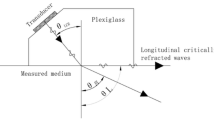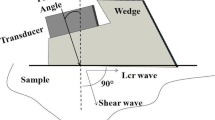Abstract
The ultrasonic residual stresses measurement is based on the acoustoelastic effect that refers to the change in velocity of the elastic waves when propagating in a stressed media. The experimental method using the longitudinal critically refracted (Lcr) waves requires an acoustoelastic calibration and an accuracy measurement of the time-of-flight on both stressed and unstressed media. The accuracy of this method is strongly related to that of the calibration parameters, namely the time-of-flight at free stress condition (t0) and the acoustoelastic coefficient (K). These parameters should be obtained on a free stress sample that has an identical microstructure to that of the stressed media. Our study concerns the ultrasonic evaluation of the welding residual stresses. This assembly process induces three distinct microstructures in the weld seam: the melted zone (MZ), heat affected zone (HAZ) and the parent metal (PM). Previously, the residual stresses evaluation in the steel welded plates, by the use of the Lcr wave method, was only possible in the MZ and in the PM zones. While in the HAZ, the residual stresses were incorrectly evaluated due to its small width impeding the extraction of the calibration sample. In this paper, we propose an original approach to solve this problem, which consists of reproducing the microstructure of this zone using a specific heat treatment. For the experimental part, P355 steel welded plates were used and the three zones were probed. The results compared with those obtained by the hole-drilling reference method show a proven potential of the ultrasonic method using the Lcr waves. The Lcr wave residual stresses measurements were made with sufficient accuracy, such as the variability of repeated measures was estimated on the order of ± 36 MPa.







Similar content being viewed by others
References
Macherauch E, Kloss KH (1986) Proc international conference on residual stresses. Gramish-Partenkirchen (FRG), pp 3–26
Grayli N, Shyne JC (1985) Effect of microstructure and prior austenite grain size on acoustic velocity and attenuation in steel. Rev Prog NDE 4B:927–936
Herzer R, Schneider E (1989) Instrument for the automated ultrasonic time-of-flight measurement. A tool for materials characterization. In: Holler P, Dobmann G, Ruud C, Green R (eds) Nondestructive characterization of materials. Springer, Berlin Heidelberg New York, pp 673–680
Palanchamy P, Joseph A, Jayakumar T (1995) Ultrasonic velocity measurements for estimation of grain size in austenitic stainless steel. NDT E Int 28(3):179–185
Papadakis EP (1984) Physical acoustics and microstructure of iron alloys. Int Mater Rev 29:1–24
Hakan Gür C, Orkun Tuncer B (2005) Nondestructive investigation of the effect of quenching and tempering on medium-carbon low alloy steels. Int J Microstruct Mater Prop 1(1):51–60
Ploix MA, El Guerjouma R, Moysan J, Corneloup G, Chassignole B (2005) Acoustical characterization of austenitic stainless-steel welds for experimental and modelling NDT. J Soc Adv Sci 17(1&2):76–81
Spies M, Schneider E (1990) Non-destructive analysis of texture in rolled sheets by ultrasonic techniques. Text Microstruct 12:219–213
Johnson GC (1985) Acoustoelastic response of a polycrystalline aggregate with orthotropic texture. J Appl Mech 52:659–663
Sayers CM (1982) Ultrasonic velocities in anisotropic polycrystalline aggregates. J Phys D Appl Phys 15:2157–2167
Hakan Gür C, Çam İ (2007) Comparison of magnetic Barkhausen noise and ultrasonic velocity measurements for microstructure evaluation of SAE 1040 and SAE 4140 steels. Materials Charact, 58(5):447–454C
Nam YH, Kim YI, Nahm SH (2006) Evaluation of fracture appearance transition temperature to forged 3Cr-1Mo-0.25 V steel using ultrasonic characteristics. Mater Lett 60:3577–3581
Cantrell JH, Salama K (1991) Acoustoelastic characterization of materials. Int Mater Rev 36:125–145
Salama K (1985) Relationship between temperature dependence of ultrasonic velocity and stress. In: Thompson DO, Chimenti DE (eds) Review of progress in quantitative non-destructive evaluation. Plenum, New York, pp 1109–1119
Mohbacher H, Schneider E, Goebbels K (1990) Temperature dependence of third-order elastic constants. Proc 9th international conference on experimental mechanics, Aaby Truk, Copenhagen 3:1189–1197
Crecraft DI (1967) The measurement of applied and residual stresses in metals using ultrasonic waves. J Sound Vib 5(1):173–192
Lhémery A, Calmon P, Chatillon S, Gengembre N (2002) Modeling of ultrasonic fields radiated by contact transducer in a component of irregular surface. Ultrasonics 40:231–236
Hoblos J (2004) Evaluation des contraintes résiduelles par méthode ultrasonore avec prise en compte des effets de la microstructure: application au cas de soudage. PhD Thesis, order number 3456, University of Sciences and Technologies of Lille, France
Hoblos J, Bourse G, Robin C, Walaszek H, Chaki S (2003) Ultrasonic stress measurement in welded joints by using Lcr waves: an approach to separate microstructure and stress effects. World Congress on Ultrasonics 2003, Paris, pp 701–704
Qozam H, Hoblos J, Bourse G, Robin C, Walaszek H, Bouteille P, Cherfaoui M (2006) Ultrasonic stress measurement in welded component by using Lcr waves: analysis of the microstructure effect. Mater Sci Forum 524–525:453–458
Qozam H, Bourse G, Robin C, Walaszek H, Bouteille P, Cherfaoui M (2007) Influence parameters on the determination of residual stresses by ultrasonic method: application to the case of pressure equipments. Eur Symp Press Equip, Paris, pp 501–509
Hughes DS, Kelly JL (1953) Second-order elastic deformation of solids. Phys Rev 5(92):1145–1149
Murnaghan FD (1951) Finite deformation of an elastic solid. Wiley, New York
Thompson RB, Lu WY, Clark AV (1996) Handbook of measurement of residual stresses. Soc Exp Mech, Connecticut, pp 149–178
Basatskaya LV, Ermolov IN (1981) Theoretical study of ultrasonic longitudinal subsurface waves in solid media. Defektoskopiya 7:58–65
Rose JL (1999) Ultrasonic waves in solid media. Cambridge University Press, Cambridge, pp 97–99
Egle DM, Bray DE (1976) Measurement of acoustoelastic and third-order elastic constants for rail steels. J Am Soc Acous 60(3):741–744
Abdallahoui Y, Walaszek H, Peyrac C, Lieurade HP, Cherfaoui M (2000) Récents développements de la mesure des contraintes résiduelles par méthode ultrasonore. Les principales sources d’erreurs. Mécanique and industries 1:187–200
Ya M, Marquette P, Belahcene F, Lu J (2004) Residual stresses in laser welded aluminium plate by use of ultrasonic and optical methods. Mater Sci Eng 382(1–2):257–264
Author information
Authors and Affiliations
Corresponding author
Rights and permissions
About this article
Cite this article
Qozam, H., Chaki, S., Bourse, G. et al. Microstructure Effect on the Lcr Elastic Wave for Welding Residual Stress Measurement. Exp Mech 50, 179–185 (2010). https://doi.org/10.1007/s11340-009-9283-0
Received:
Accepted:
Published:
Issue Date:
DOI: https://doi.org/10.1007/s11340-009-9283-0




